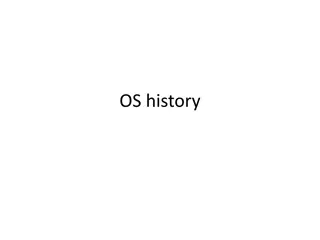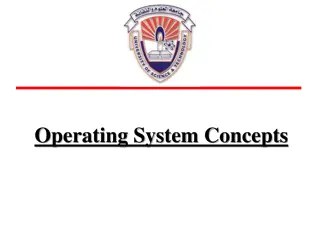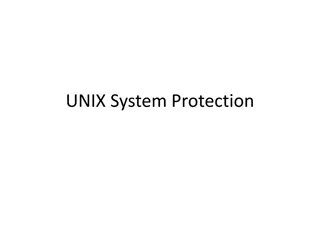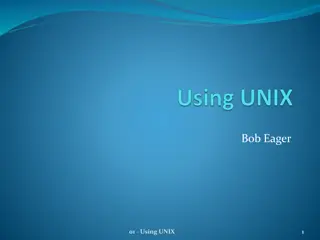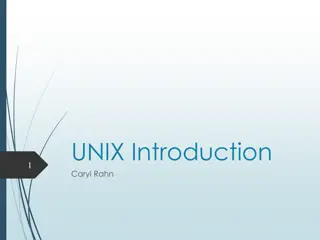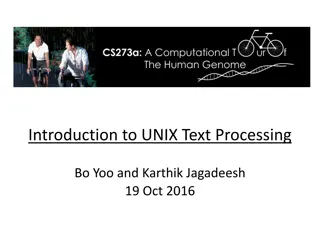Introduction to Bash Shell Programming
Learn about the fundamentals of shell programming in Unix/Linux systems, including the role of the shell as an interface between users and the operating system. Understand the components of a shell, such as the kernel, and explore different types of shells like Bourne Shell and C Shell. Discover how
7 views • 17 slides
Evolution of Operating Systems: From Mainframe Computers to Unix
Before the 1950s, users interacted directly with mainframe computers without an operating system, debugging using control panels. The transition to writing programs in symbolic languages led to the need for specific drivers. Run queues and operator-assisted job submissions marked this era. The first
0 views • 41 slides
NASA Platform Layer Updates for the CAELUM (7.0) Release
The National Aeronautics and Space Administration (NASA) discusses platform layer updates for the CAELUM (7.0) release of the Core Flight System in the 2021 Flight Software Workshop. The platform layer consists of the Operating System Abstraction Layer (OSAL) and Platform Support Package (PSP), whic
1 views • 20 slides
Introduction to Unix-like Systems and Shell Interaction
Unix-like systems, such as Linux, Android, iOS, and macOS, are prevalent in various devices. The Unix shell acts as an intermediary between users and the operating system, allowing for program execution and process management. Secure Shell (SSH) and X Window System enable remote machine connections
4 views • 19 slides
Evolution of Operating Systems: A Historical Journey
Explore the fascinating evolution of operating systems from the late 1950s to the 1970s, including key milestones such as the development of Unix, DOS, and Windows. Discover how operating systems have progressed to support multi-tasking and multi-user capabilities, dynamic address translation, and m
1 views • 89 slides
UNIX and Linux Operating Systems
UNIX, known as the mother of most operating systems, follows a design philosophy rooted in plain text data storage, hierarchical file systems, and modular programs. The UNIX kernel controls system functions, while Linux, a Unix-like OS, operates as a free and open-source alternative developed from s
3 views • 4 slides
Operating System Concepts: Lecture Overview and Services
Exploring the lecture content on operating system concepts, structures, services, system calls, and file manipulation. Delve into the importance of operating system services, error detection, program execution, I/O operations, protection, security, and resource allocation in operating systems. Learn
5 views • 26 slides
Introduction to UNIX Programming Languages and Program Development
Discover the fundamentals of UNIX operating system, its significance in modern computing, directory structures, pathnames, and the role of CPU in computer systems. Learn why understanding UNIX can be essential for efficient program development and resource management. Explore the distinction between
0 views • 42 slides
The Make Utility in Linux/Unix Operating Systems
The Make utility in Linux/Unix is a command generator designed to assist in compiling large projects efficiently by using Makefiles with rules and dependencies to determine and execute necessary tasks. It minimizes recompilation, reduces resource usage, and streamlines complex program compilation pr
0 views • 21 slides
UNIX System Permissions and User Terminology
Explore the concept of UNIX system permissions, including discretionary access control (DAC) model, user terminology, file/directory access, access permission modes, categories of users, and checking permissions using examples. Learn about user IDs, groups, superuser privileges, ownership, access mo
1 views • 24 slides
Overview of UNIX System Protection
UNIX System Protection focuses on ensuring security and access control mechanisms within the UNIX operating system. Developed in 1969 by Dennis Ritchie and Ken Thompson at AT&T Bell Labs, UNIX features design elements like a portable API, protection rings, kernel processes, and a trusted computing b
0 views • 12 slides
Introduction to Linux System Administration
Explore the fundamentals of Linux system administration, including accessing Linux systems, using SSH for secure connections, setting up virtual machines, understanding the Unix system kernel and shell, and grasping the multi-user and multi-process aspects of Unix. Enhance your skills in managing Li
1 views • 42 slides
Unix Shells: A Comprehensive Overview
Explore the fundamentals of Unix shells, including their role as an interface between the Unix kernel and users, different shell types like Bourne, Korn, and Bourne-again shells, shell startup files, environment variables, and more. Learn how shells interpret and run commands, manage aliases, and co
0 views • 40 slides
Unix Process Management
Unix process management involves the creation, termination, and maintenance of processes executed by the operating system. A process is the context maintained for an executing program, essential for managing concurrent activities efficiently. This includes process creation, termination, process birt
0 views • 85 slides
CS252 Systems Programming Course Overview
This course overview covers topics such as C programming review, Unix basics, Unix systems programming, and grading details. The course includes labs on C/C++ programming, Unix shell scripting, and writing your own shell. Communication is emphasized through Piazza for questions/answers and Blackboar
0 views • 41 slides
Filesystems and Inodes in UNIX
Delve into the complexities of filesystems such as FFS and LFS, exploring concepts like i-nodes, ownership, permissions, and indirect blocks. Learn about the structure of UNIX inodes, path searching, caching, read-ahead optimization, and the limitations of the original UNIX filesystem. Unravel the i
1 views • 24 slides
Dyalog APL on UNIX - Development Environment Overview
Discover the supported platforms for Dyalog APL on UNIX, including AIX and various Linux distributions. Learn about driving APL on UNIX, using PuTTY for Windows clients, configuring terminal windows, and running TryAPL as a service. Get insights on setting up Dyalog APL on Linux and explore keyboard
1 views • 39 slides
Essential Unix Commands for Beginners
Learn essential Unix commands such as pwd, ls, cd, mkdir, and man, along with their functionalities and usage in navigating the Unix file system effectively. Understand the basics of directories, file structures, and how to get help using the command line interface.
0 views • 18 slides
Introduction to the Command Line: Basic Commands and Unix Systems
This material provides an overview of fundamental commands in Unix systems, applicable to both Unix and Linux operating systems. It covers topics like directory structure, text file manipulation, file permissions, redirections, pipes, wildcards, and more. Learn about the nature of Unix systems, how
0 views • 43 slides
Unix: Fundamentals and Connections
Explore the basics of Unix operating systems, terminology, types of Linux installations, and connecting to remote Linux machines. Learn about key concepts such as local vs. remote connections, SSH connections using passwords and keys, and tools like PuTTY for remote access.
0 views • 78 slides
Introduction to Using UNIX: A Comprehensive Guide
Explore the rich history and practical benefits of using UNIX systems. Learn about the UNIX user interface, the significance of command line interactions, the philosophy of small programs, and the evolution of graphical interfaces. Discover why mastering UNIX skills is valuable for computing student
0 views • 29 slides
UNIX Operating System
UNIX is a versatile operating system that enables multi-user access, multitasking, and portability across various computing environments. It serves as the foundation for many modern operating systems and has influenced concepts incorporated in Microsoft Windows and DOS. The UNIX system comprises dis
0 views • 51 slides
Architectural Hardware Support for Operating Systems in ECE344 Lecture
The lecture discusses the importance of hardware support in operating systems, emphasizing the management of hardware resources and providing a clear interface to programs. It explores the fundamental relationship between operating system functionality and hardware, highlighting how hardware support
0 views • 53 slides
Exploring Unix Input and Output Topics in CS.105
Dive into the Unix I/O philosophy, understanding pathnames, conventions, and file structures. Learn how Unix revolutionized file handling with its unified approach and discover the power of accessing files, reading/writing, pipes, and filters. Gain insights into Unix file conventions and the flexibi
0 views • 29 slides
Introduction to Linux: Course Overview and Objectives
This introduction to Linux course provides a comprehensive overview of operating systems, including the history, variations, user interface, and essential commands. The course is designed with lectures, labs, and exercises to help participants gain a better understanding of Linux and its practical a
2 views • 77 slides
Operating Systems: An Introduction and Overview
An operating system is a crucial program that manages computer hardware and serves as an intermediary between users and hardware. This chapter explores the role of operating systems in a computer system, covering components like hardware, application programs, and users. It delves into how operating
0 views • 16 slides
Evolution of Data Abstraction in Operating Systems
Explore the evolution of central data abstraction in operating systems from the complexity of Multics to the simplicity and elegance of Unix. Discover how files are managed in Unix, the tradeoffs in data-sharing methods, and the impacts on efficiency and protection.
0 views • 41 slides
Introduction to Shell Scripting in UNIX and Network Programming
Shell scripts in UNIX and network programming provide a powerful way to automate tasks, simplify recurring operations, and enhance system administration. They leverage variables, decision-making control, looping abilities, and function calls to streamline processes. With essential features like file
0 views • 32 slides
Process Management in UNIX Systems
Explore the intricate process management mechanisms in UNIX operating systems, covering the suspension, activation, and destruction of processes along with resource allocation and priority handling. Delve into the scheduling intricacies of UNIX environments for optimal performance.
0 views • 18 slides
Introduction to Data Analysis in Geophysics Using UNIX
Learn how to use UNIX commands such as pipes and xargs in geophysics data analysis. Discover how to manipulate file lists, search for specific strings in files, and run programs on file names efficiently using xargs in a UNIX environment.
0 views • 34 slides
Introduction to UNIX Commands and Basic C Programming Exercises
This content guide provides step-by-step instructions on downloading, unpacking, and using examples in UNIX environment, connecting to a university UNIX account from Windows using Putty, logging in with UPI and password, and running basic C programming exercises. It also covers basic Linux commands
0 views • 13 slides
UNIX Operating System and File System
UNIX is a powerful operating system developed in the 1960s that forms the basis for modern systems like Linux. It manages hardware communication for users and programs. The file system organizes files in a hierarchical structure, with directories acting as folders. Learn about directories, subdirect
0 views • 19 slides
Unix Process Management in Computer Systems II
This overview delves into the creation, termination, memory layout, and dynamic memory management of Unix processes in Computer Systems II. It covers the distinctions between code, executables, and processes, the memory layout of Unix processes, management of heap memory using malloc and free functi
0 views • 27 slides
Introduction to Linux Workshop and History: A Brief Overview
Delve into the world of Linux with an introduction to its basics, operating system functionalities, and a quick history lesson from the Unix roots to the release of Linux. Explore the significance of Linux as an operating system and the evolution of computing. Get insights into key milestones like U
1 views • 98 slides
Mastering UNIX Text Processing: Tips and Tricks
Explore the world of UNIX text processing through a comprehensive guide covering essential commands, efficient workflows, and powerful combinations. Learn how UNIX commands streamline tasks, eliminate redundant code, and enhance productivity. Discover the art of piping, output redirection, and utili
0 views • 48 slides
Linux and Its Importance in Computing
Linux, a Unix clone developed by Linus Torvalds in 1991, is a widely used operating system powering servers, mobile phones, and other devices. It emphasizes the collaborative nature of software development and the synergies between different programs. This overview delves into key aspects of Linux,
2 views • 49 slides
Overview of UNIX and Linux Operating Systems
The UNIX brand encompasses a range of powerful multitasking, multiuser operating systems used by various organizations to develop IT technologies. UNIX internals consist of kernel space and user space, with programs accessing system services rather than hardware directly. The Unix filesystem is a ke
2 views • 36 slides
Operating Systems: Principles and Practice in CSE Curriculum
Dive into the world of operating systems through the lens of "Operating Systems: Principles and Practice" by Tom Anderson. Discover how this course fits in the UW CSE curriculum, covering systems programming, operating system interfaces, and distributed systems. Explore the project work on building
0 views • 21 slides
Introduction to Basic UNIX Usage and Network Programming
In this course, you will learn the fundamentals of UNIX usage and network programming. Topics covered include basic UNIX commands, file system structure, UNIX shell functionalities, command line structure, and essential commands like passwd, ls, more, logout, date, and man. Understanding the hierarc
0 views • 31 slides
Introduction to UNIX System and Homework Assignment in CS 240
Learn about connecting to the CS department's UNIX system, setting up accounts, using SSH clients on Windows, Mac, and Linux, navigating the filesystem, and performing commands in the command line interface. Get started with your CS 240 assignments effectively.
0 views • 19 slides

